- Home
- About Us
- Join/Renew
- Member Benefits
- Member Pages
- Log In
- Help
- Museum Store
Arthur Edward George
Born June 1875, He was a talented athlete, being a swimmer, figure skater and racing cyclist at international level.
After serving an engineering apprenticeship in Newcastle, he lived for some time in South Africa, where he became national cycling champion and represented South Africa at the 1899 UCI Track Cycling World Championships in Montreal, Canada. He served with the Cape Colony Cyclist Corps from 7 January 1901 until 12 May 1902 in the Second Boer War, receiving the Queen’s South African Medal with three clasps.
On his attestation (joining-up) form he is described as being:
Age: 23
Nationality: English
Trade: Cycle Mechanic
Height: 5ft 10 ½ in
Weight: 150 lbs
Chest: 38in
Complexion: Fair
Eyes: Blue
Hair: Black
Character: Very Good
It was noted: “Supplies own bicycle”
There is a good British show called “Salvage Squad” which covers his life during his career as a race car driver at Brooklands, England. It was said he left cycling after a bad accident. Being a racer he built his own specially designed race car called “The Golden Ford”. This was a 1911 Ford Model T with an overhead valve train, centered steering, and fully brass body. Apparently he did well enough to win at Brooklands and accept the winning a trophy from Henry Ford.
You can watch the YouTube show below.
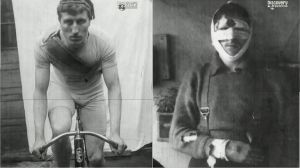
In case you were wondering, here is an advertisement for the Pierce Racer from 1897. This is similar to the bike A.E. George rode in the picture above.
Note the price of $100. That would be approximately $2,857.00 USD today.

Benjamin,
Thank you very much for your post. I am always fascinated by posts that talk about the “Other” Pierce products, Ice Boxes, Wagons, cycles (both manpowered and horse powered),etc. I have been intrigued with the manufacturing complexity of companies in the early 1900’s. Hope to see more posts.
Bill
I have a Pierce “Special Racer” like the one shown in the advertisement. It came out of the Pedaling History museum in New York, and has one crank arm sawn off….when I asked the late Mr. Burgwardt why, he said he had pictures of the fellow who’d raced it, he only had one leg….I never got the pictures, and never understood the reasoning, the crank wouldn’t be in his way, and weight was minor.
Note that the Racer has no brakes and fixed gearing, or in other words, no “free wheeling”, if the rear wheel is turning then the rider’s legs are moving too….
You are right, David.
Pierce racing models did not come with brakes. I guess if you wanted to stop, you just put your feet down!
Pictured is two different bicycle rear hubs. The first is of a wooden wheel racing bike. Although the quality of the photo is not great, you can see there is no hub brake. The second photo is a New Departure Model D skip-tooth hub. This is a reverse brake hub and was used on later Pierce bikes.
New Departure made a series of rear hubs – Model A through Model D.

This is a track race bike as opposed to a road race bike. All track bikes are stripped down to the bare minimum: no brakes, no gears, no water bottles, no free wheeling ratchet system in the rear hub, etc. As mentioned above, and true of all track bikes, if you stop peddling, the rear wheel stops rotating! In addition, many track racers had their shoes bolted to the pedals so there was no chance of ones feet slipping off. The down side was that if you fell down, you could not pull your feet out to stop your fall. These types of bikes are raced on indoor tracks.
Here’s a live Racer owned by Jeff Powell. It’s all original. We did a feature on it in the “Great Lakes Archer””.
Bill”
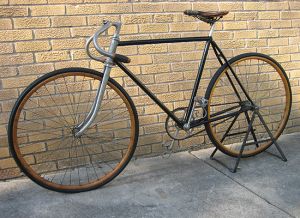
Thanks Bill for sharing this picture of the Racer.
I have not read the article about this bike but think I might be able pick up a copy from someone.
I found this information in the 1904 Pierce Cycles catalogue. Notice the picture shows the full nickeled forks and the difference between the two forks. These must have been incredible to see on the roads when they were new.
Model No. 521 – Racer.
Bright carmine frame. Full nickel forks. Aluminum finished rims. Palmer 1 ¼ – inch road tires. No. 211 Handle Bars. Troxel No. 30 B Saddle. 6 ½ – inch Cranks. Racing Pedals. 84 Gear. 3/16 – inch Lefever nickel-steel chain.
Model No. 520 – Pacer.
26-inch front and 28-inch rear wheels. Bright carmine finished frame. Aluminum-finished rims. Full nickeled STRAIGHT forks. Palmer 1 ¼ –inch road tires. No. 221 Handle Bars. Brown BB Saddle. 6 ½- inch Cranks. Racing Pedals. 84 Gear. 1/8 – inch nickel steel chain.
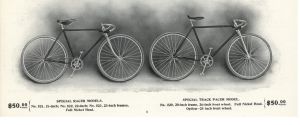
Here is some semi-related trivia.
Check out Arthur Augustus Zimmerman as an early bicycle racer.
I attach photo of a belt buckle (PAS reproduction – long ago) awarded to him by the G. N. Pierce Dealers.
However, I do not believe he ever competed on a Pierce bike.
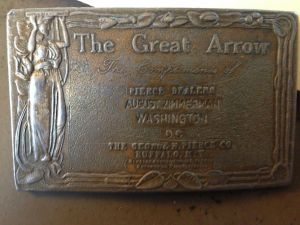
Peter, thanks so much, I have a couple of those buckles with Zimmerman name, knew they were a reproduction, but didn’t know the connection to a bicyclist. If anyone wants one of these it’s available, I have two and would sell one for $25.
I also have two other of the same style buckle, one has name ‘Carl Nickum Waukegan Illinois” and the other “”Norman C. Hopper Salt Lake City Utah””. Any idea who those guys were?”
Thanks Peter for the trivia of Arthur A. Zimmerman.
David, I found the following information.
Norman C. Hopper (1880 – 1956)
Hopper was a pro cyclist from Minneapolis, MN. In the September 30, 1905 edition of The Bicycling World and Motorcycle Review, Hopper placed FIRST in a Two-mile open, professional event. He did well in other events and was part of the Mormon Team with C.L. Hollister of Salt Lake City.
According to the December 22, 1906 edition of The Summary, he was one of 16 who participated in a “Ten-Mile Event in Madison Square Garden” This was an International Ten-Mile bicycling event which he did well but did not finish. According to an abstract of the December 2, 1905 The New York Times, “There were 8,000 patriotic Americans crowded into Madison Square Garden last night to see the international bicycle races contested there by the crack riders from all over the world. They came to see an American victory in every race, and seeing it, went away amid the strains of “Hail, Columbia,” well satisfied.”
Fast-forward and his name reapers in the August 24, 1922 edition of Motorcycle and Bicycle Illustrated. The article mentions that Hopper is selling his Salt Lake City Indian Motorcycle dealership to Floyd Clymer of Denver. Hopper also owned the Harley-Davidson dealership in Salt Lake City, which he retained after selling the Indian dealership.
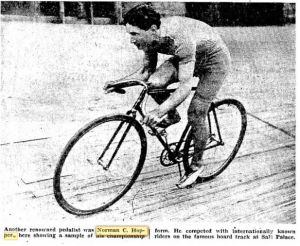
Thanks for the info on Mr. Hopper, I searched but missed it….does anyone know the history of these belt buckles? Everyone has said, and I’m not questioning, that they are long ago reproductions, but to what purpose? And why do they have names of cyclists? Who reproduced them and when?
Inquiring minds want to know!! thanks!
David,
Thanks for outdoing me by having TWO Zimmerman buckles and a few others.
Heck, I figured that I could sell mine to Ben for $5,000.00, but that deal is shot! HA!
Considering the diversity of buckles described (three different names), perhaps they are not PAS reproductions, but product runs of the time, like by the PAMCC Dealer’s Association.
What do you think?
Peter
Hello All,
Here is Carl Nickum, or at least his US Patent.
It looks a lot like what people use today to do quick fixes on flat tires.
Only one page posts, so you can find the others by doing a search for US Patent #1,363,163.
Peter
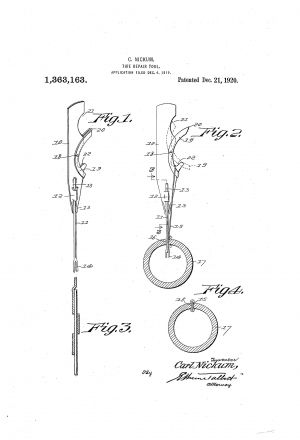
AH, Sunday Morning goofing off,
Here is more on Carl Nickum from Motorcycle Illustrated, 12 October, 1916.
MAIN BUYS OUT NICKUM, WAUKEGAN Ill
M. T. Main has purchased the business of Carl Nickum, at 131 South Genesee Street and will continue to handle the Harley Davidson for 1917. He will also sell bicycles and accordingly has closed with the Excelsior folks to handle their wheels. Main sells on time asking one half down and the balance at the rate of $1 per week
Shucks, Peter, did I say $25? Of course I meant $2500!
I started collecting Pierce memorabilia a good while ago, and these buckles show up every now and then, and I was told once they were repros. The Zimmerman name is the one that seems to pop up every once and a while, and the two other names I have are the only ones I’ve seen other than that. It’s an odd thing to repro, though, and with the different names even odder. Does anyone have any knowledge of the truth? I can handle the truth….
The wording is funny, too, “Great Arrow the compliments of”….
Just sharing, Peter, not trying to outdo you!!!
David,
I did some searching for Lewis Buckles, Chicago, and it is reported that they did a slew of reproductions and “Fakes-of-Fakes” in the 1960s or so, when there was a “belt buckle” craze.
It is not at all clear that our lovely G. N. Pierce belt buckles are reproductions rather than fakes-of-fakes, but they remain interesting and are at least 50-years-old.
BTW, no need to have concern.
Peter
http://newsok.com/belt-buckle-just-a-fake-of-a-fake/article/2303132
As far as fakes go, there are also lots of fake watch fobs, made in the 50′ and 60’s. I have only seen two real ones, and a bunch of fakes. You see them in Stutz, Packard, and Cadillac also. I have seen the belt buckles years ago, in a display case at Hershey. The were being sold as authentic. Be careful out there!
Yes, agree with Ed.
An authentic watch fob should have writing engraved on the back, manufacturers name I think, and usually a silk ribbon. Side by side with a repro, it’s “richer” looking too. I’ll post two pics of one, to be verified original by Ed!! He saw some of my memorabilia collection so hopefully this is one of the ones he’s referencing!
The belt buckles seem to be fake, as mentioned, they pop up quite often so that’s probably the truth.
The Pierce 1901-1911 anniversary medal also pops up as a fake, I think someone did a batch of them in the ’60’s. VERY easy to tell real from fake, the real ones have a heft to them like bronze or something similar, the fake ones are very light like aluminum. I’ll post a picture of a real one.
back of watch fob….
